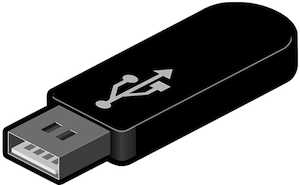USB thumb drives are a convenient and portable means of storing data. However, how long can flash drives actually keep your data maintained? Are they really useful for storing information for an extended period of time?
Note: These are often called flash drives or flash memory or thumb drives or USB drives or possibly other names. The reality is that they all are the same things.
 Most technical gurus will tell you that a good USB drive can function for an average of 10 years or longer. The actual data lifespan varies depending on build quality, write cycles, temperature, and storage conditions of a thumb drive. However, the “real-world” life expectancy is somewhat more complicated.
Most technical gurus will tell you that a good USB drive can function for an average of 10 years or longer. The actual data lifespan varies depending on build quality, write cycles, temperature, and storage conditions of a thumb drive. However, the “real-world” life expectancy is somewhat more complicated.
First, there is the phrase “an average of 10 years or longer.” Think about that one word: “average.” What that really means is that of all the “good USB drives” available today, an average means that about half of them will last less than 10 years while the other half will last longer than 10 years. That’s the definition of an average. The question is: how do you tell in advance that the flashdrive in your hand is going to last more than or less than the average of all flashdrives?
Yes, half of the “good USB drives” will fail in less (sometimes much less) than 10 years.
Next, how do you tell that your flashdrive is one of the “good” ones? Does the flashdrive you purchase on sale qualify as a “good” one or is it perhaps a more-cheaply built one?
How about the storage conditions of a thumb drive.? Are you keeping it in a room at home or the office where temperatures and humidity remain fairly constant or are you keeping it in the glovebox of your automobile or perhaps in your purse or pocket? Yes, temperature, and storage conditions of a thumb drive will greatly affect the life expectancy of a flashdrive.
Luckily, there are a few simple solutions to these questions.
First of all, you should have a basic understanding of how usb thumb drives store data. They use NAND flash memory to store data. NAND flash memory is a non-volatile storage type, meaning it retains data even when the power is disconnected. This feature makes it ideal for portable storage devices like USB thumb drives.
Unlike old-fashioned hard drives, there are no moving parts in a flashdrive. Next, they are rugged. Yes, even the cheapest flashdrives can be bounced around, dropped, and otherwise abused. They don’t withstand crushing, however
NAND flash memory stores data in memory cells. These cells use electrons trapped in a “floating gate” to represent binary values (0s and 1s). The biggest threat to data stored in flashdrives is that, over time, the electrical charge in these cells can leak, leading to data degradation because it becomes harder to read whether the charge level represents a 1 or 0. While a thumb drive might seem like a pretty sturdy storage device thanks to its solid-state nature, several factors can impact the longevity of data stored on a USB thumb drive.
Perhaps the biggest risk concerns the quality of the drive: The quality of the NAND flash memory and the overall construction of the drive can significantly affect data retention. Cheaper, lower-quality drives may have a shorter lifespan. Unfortunately, there is no method of determining the quality simply by looking at the flashdrive.
Flash memory has a finite number of write cycles (i.e., how often data can be written and erased). As the number of write cycles increases, the likelihood of data degradation also increases, and eventually, you’ll get total drive failure. In short, they may be considered to be “write infrequently, read frequently” devices.
Extreme temperatures can negatively affect data retention. Prolonged exposure to high temperatures can cause the trapped electrons to leak faster, leading to data loss.
Humidity, dust, and other environmental factors can also influence the longevity of data stored on a USB thumb drive. Unfortunately, there is no easy way of determining how much of an impact environmental factors can impact a particular flashdrives. Some (higher quality) flashdrives are hermetically sealed while cheaper drives normally are not. Again, there is no method of determining the quality of construction simply by looking at the flashdrive.
So What Should You Do to Ensure Longevity of Your Data?
The easiest way to is to do the same as you do to making backups to other media: make multiple copies and store the copies on different flashdrives (or a variety of other media). You DO make multiple copies of your backups, don’t you?
Next, verify the stored data periodically. The easiest way to do this is to copy the entire flashdrive from one flashdrive to another flashdrive periodically. Your computer is very good at detecting errors when the copy software encounters errors. If there is a problem with corrupted data on the flashdrive, you will know about it withing seconds after encountering the error. This also has the added benefit of easily making extra copies of your data, as mentioned earlier. There is no “magic” as to determining how often to copy the device. I try to copy my stored flashdrives once every fiscal quarter (every three months).
How Long Should It Last?
There is no definitive answer to this lifespan question for data stored on a USB thumb drive because it depends on the above-mentioned factors. However, under normal storage conditions and usage, a high-quality USB thumb drive should be able to retain data for at least 10 years. Again, I will repeat what I wrote earlier: “The actual data lifespan varies depending on build quality, write cycles, temperature, and storage conditions of a thumb drive. However, the “real-world” life expectancy is somewhat more complicated.”
Flashdrives are some of the most useful tools any computer user can own. However, like all other tools, it is necessary to know how to use the tool and what the tool’s capabilities are. Perhaps knowing the limitation of each tool used is the best method of preventing frustrations.
 Latest News Articles
Latest News Articles If you do not see a Plus Sign that is labeled "Add comment," you will need to upgrade to either a (FREE) Standard Edition or a (paid) Plus Edition subscription
If you do not see a Plus Sign that is labeled "Add comment," you will need to upgrade to either a (FREE) Standard Edition or a (paid) Plus Edition subscription